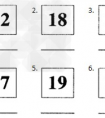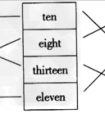Thereare_________daysinaweek.The________dayisSaturday.[ ]A.seven;sevenB.seventh;seventhC.seven;seventhD.seven;sixth-六年级英语
in the year two fifty-three B.C. 在公元前253年
但是,通常采用in加表示年份的阿拉伯数字。
B. 月份,在哪个月用介词in加第一个字母大写的月份词表示。
例如:in May在五月; in July在七月。
为了简便起见,月份与日期连用时,月份常用缩写形式表示。
缩写形式除May,June,July外,其它的月份都由其前三个字母表示,但September除外。
January——Jan.一月
February——Feb.二月
March——Mar. 三月
April——Apr.四月
August——Aug.八月
September——Sept.九月
October——Oct.十月
November——Nov.十一月
December——Dec.十二月
注:这里缩写形式后面加点不能省略,因为它是表示缩写形式的符号。
C.日期用定冠词the加序数词表示。在哪一天要添加介词on。
National Day is on Oct. 1.
国庆节是十月一日。(读作 October first)
此句也可以表示为 National Day is on the 1st of October.
May 5 五月五日(读作May fifth)
也可以表示为the fifth(5th)of May
Mar. 1(st) 三月一日(读作March first或 the first of March)
5. 表示不具体、不确切的时间,如世纪、年代、年份、月份时,用介词in表示;
表示具体确切的某一天用介词on表示通常情况下morning,afternoon,evening等词前用介词in。
但是,当这些词前后有一修饰限定的词作为定语,把它们限定为某一天早晨、下午或晚上时,介词in应改为on。
这里的修饰限定词可以是介词短语、名词、形容词、定语从句等。
On a cold morning,the old man died lonely in his house.
在一个寒冷的早晨,这个老人孤独地死在自己的房子里。
I don/’t want to be disturbed on nights when I have to study.
我不愿意在我必须学习的晚上被打扰。
The accident happened on the afternoon of July 7.
这次事故发生在7月7日下午。
We are to have a small test on Monday morning.
星期一早晨我们将进行一次小测验。
四、加减乘除表示法
1. “加”用plus,and或add表示;“等于”用is,make,equal等词表示。
2+3=? 可表示为: How much is two plus three?
2+3=5
Two plus three is five.
Two and three is equal to five.
Two and three make five.
Two added to three equals five.
If we add two to/and three, we get five.
二加三等于五
2. “减”用 minus或 take from表示
10-6=? How much is ten minus six?
10-6=4
Ten minus six is four.
Take six from ten and the remainder is four.
Six (taken) from ten is four.
十减去六等于四
3. “乘”用time(动词)或multiply表示
3×4=? How much is three times four?
3×4=12
Three times four is/are twelve.
Multiply three by four,we get twelve.
Three multiplied by four makes twelve.
三乘以四等于十二
4. “除”用divide的过去分词形式表示
16÷4=? How much is sixteen divided by four?
16÷4=4
Sixteen divided by four is four.
Sixteen divided by four equals/gives/makes four.
十六除以四等于四。
考点名称:序数词
- 序数词:
即表示顺序的数词。
A、1-3的序数词。 第1 first 第2 second 第3 third
B、4-19的序数词的表示方法,是由“基数词+ th”构成。
如:第4 fourth 第5 fifth 第8 eighth 第18eighteenth
C、20-100的序数词的表示方法。
a. 整数的表示方法,是把整数基数词的词尾“y”改写成“i”,然后加-eth,如:第20 twentieth 30 thirtieth
b. “百”的序数词的表示方法是在hundred词尾直接加“-th”如:第100 a hundredth
c. 其他两位数序数词的表示方法:由基数词变化而来,十位数不变,个位数上的基数词变成序数词,中间用连字符“-”连接。如:第21 twenty-first 第52 fifty-second - 序数词的缩写:
有时,序数词可以用缩写形式来表示。主要缩写形式有。
first—lst
second—2nd
third—3rd
fourth—4th
sixth—6th
twentieth—20th
twenty-third——23rd
其中lst,2nd,3rd为特殊形式,其它的都是阿拉伯数字后加上th。 - 基数词变序数词方法口诀:
口诀 解说 举例 基变序,有规律,后边th加上去 在数词后面加th。 four→fourth 一二三,特殊记,后面字母t,d,d。 one,two,three特殊变。 first,second,third 八去t,九去e。整数中的y要变成ie eight去掉t,nine去掉e。twenty去掉y变成twentieth eight→eighthnine→ninth f来把ve替。 five和twelve的ve要变成f。 five→fifthtwelve→twelfth 若是遇到几十几,只变个位就可以。 两位数或两位以上数字只变个位。 thirty-three→thirty-third 序数词前要加the我们一定要牢记。 序数词前必须加the(上述原则中的除外) thefirstday 序数词表示法:
一、分数表示法
1. 分数是由基数词和序数词一起来表示的。基数词作分子,序数词作分母,除了分子是“1”以外,其它情况下序数词都要用复数形式。
3/4 three fourths或 three quarters
1/3 one third或a third
24/25 twenty-four twenty-fifths
3又1/4 three and one fourth或 three and one quarter
1/2 a half
1/4 one quarter或a quarter
1又1/2 one and a half
1又1/4 one and a quarter
2. 当分数后面接名词时,如果分数表示的值大于1,名词用复数;小于1,名词用单数。
1又1/2 hours 一个半小时(读作 one and a half hours)
2又3/4 meters 二又四分之三米(读作two and three-fourths meters)
4/5 meter 五分之四米
5/6 inch 六分之五英寸
3. 表示“n次方”的说法:指数用序数词,底数用基数词。
10的7次方 the seventh power of ten(ten to the seventh power)
6的10次方 the tenth power of six(six to the tenth power)二、百分数表示法
百分数用基数+percent表示
50% fifty percent 百分之五十
3% three percent 百分之三
0.12% zero point one two percent 百分之零点一二
这里的percent前半部per表示“每一”,cent这一后半部分表示“百”,所以百分之几中percent不用复数形式。三、数量表示法
1. 表示长、宽、高、面积等,用基数词+单位词(meter,foot,inch,kilogram等)+ 形容词(long,wide,high等)表示,或者用基数词+单位词 + in + 名词(length, width, height, weight等)表示。
two meters long或 two meters in length 2米长
three feet high或 three feet in height 3英尺高
four inches wide或 four inches in width 4英寸宽
This box is 2 kilograms in weight.
这个盒子有两千克重。
The city wall of Xi/’an is 12 meters wide and 12 meters high.
西安城墙是12米宽,12米高。
2. 表示时间、距离时,使用含数词的名词所有格形式作定语。
five minutes/’ walk
步行五分钟(的距离)
It/’s an hour/’s ride from my hometown to our university.
从我的家乡到我们大学是乘车一小时的路程。
或:从我的家乡到我们大学需要乘车一小时。
It/’s three kilometers/’ distance from our campus to the Bell Tower.
从我们校园到钟楼有三公里远。
3. 表示温度时,用below zero表示零下温度,温度用基数词+degree(s)+单位词(centigrade摄氏或Fahrenheit华氏)表示。
thirty-six degrees centigrade或 36℃ 摄氏 36度
four degrees below zero centigrade或 -4℃ 摄氏零下4度
Water freezes at thirty-two degrees Fahrenheit.
水在华氏三十二度时结冰。
Water boils at one hundred degrees centigrade.
水在摄氏一百度时沸腾。
这里的单位词在人们都很清楚是什么度量制度时,可以省略。
You are 37℃.(读作 thirty-seven degrees)
你是三十七度。(摄氏)
It/’s seven degrees below zero.
今天是零下七度。(摄氏)
4. 由数词和其他名词构成的名词性短语作定语时,其中的名词用单数形式,名词性短语中各部分间要用连字符“-”来连接。
It/’s a five-minute walk from the library to the playground.
从图书馆到操场需要走五分钟。
She/’s a sixteen-year-old girl.
她是个十六岁的女孩。
5. 表示“比···大(或)几倍”的说法。
- 最新内容
- 相关内容
- 网友推荐
- 图文推荐
| [家长教育] 孩子为什么会和父母感情疏离? (2019-07-14) |
| [教师分享] 给远方姐姐的一封信 (2018-11-07) |
| [教师分享] 伸缩门 (2018-11-07) |
| [教师分享] 回家乡 (2018-11-07) |
| [教师分享] 是风味也是人间 (2018-11-07) |
| [教师分享] 一句格言的启示 (2018-11-07) |
| [教师分享] 无规矩不成方圆 (2018-11-07) |
| [教师分享] 第十届全国教育名家论坛有感(二) (2018-11-07) |
| [教师分享] 贪玩的小狗 (2018-11-07) |
| [教师分享] 未命名文章 (2018-11-07) |


![Hello! You can see ___________crayons. [ ]A. threeB. fourC. five-三年级英语](http://www.00-edu.com/d/file/ks/4/1/15/2019-08-13/small07da1502b58cf7152f184ff6e541c84b1565709386.jpg)



